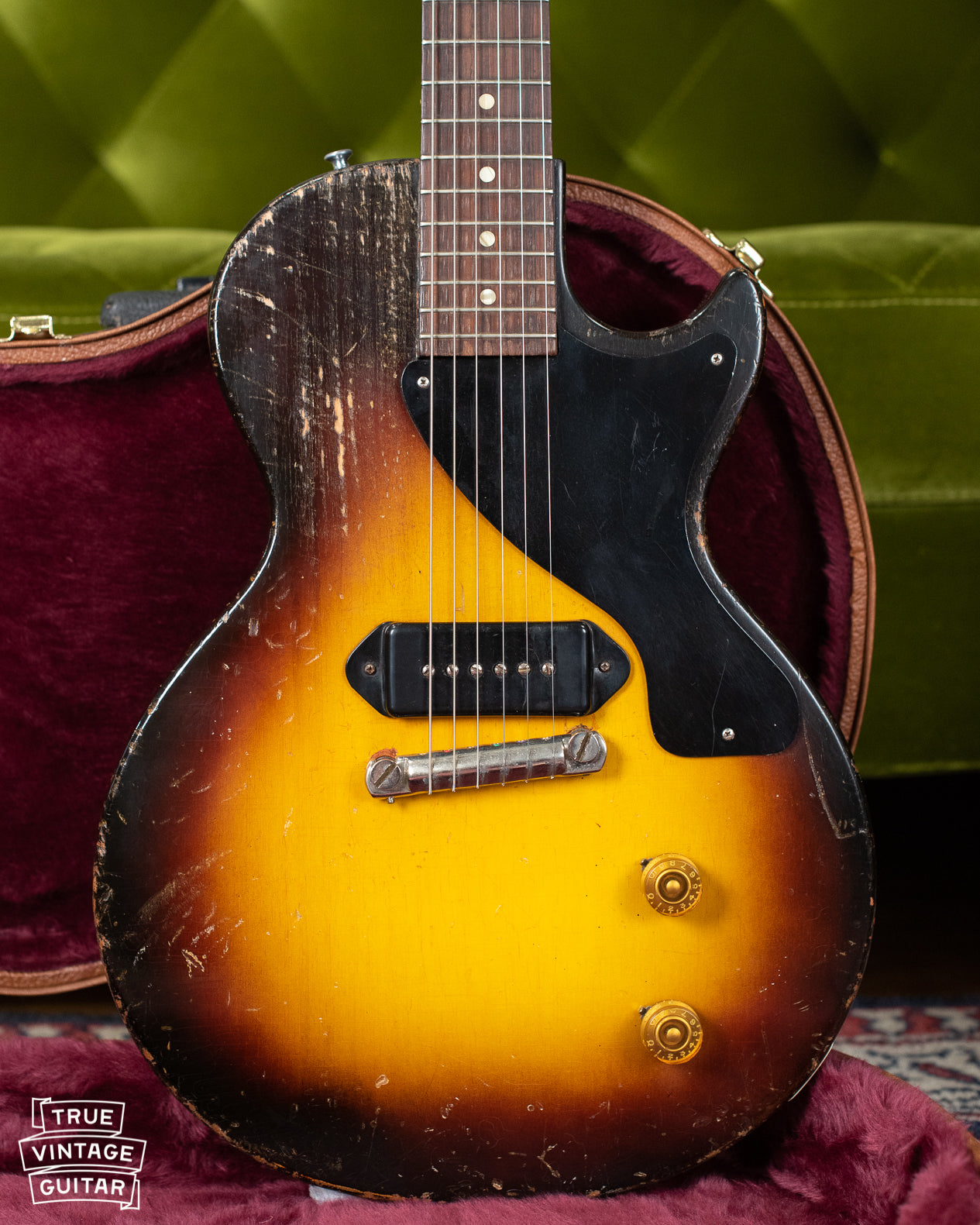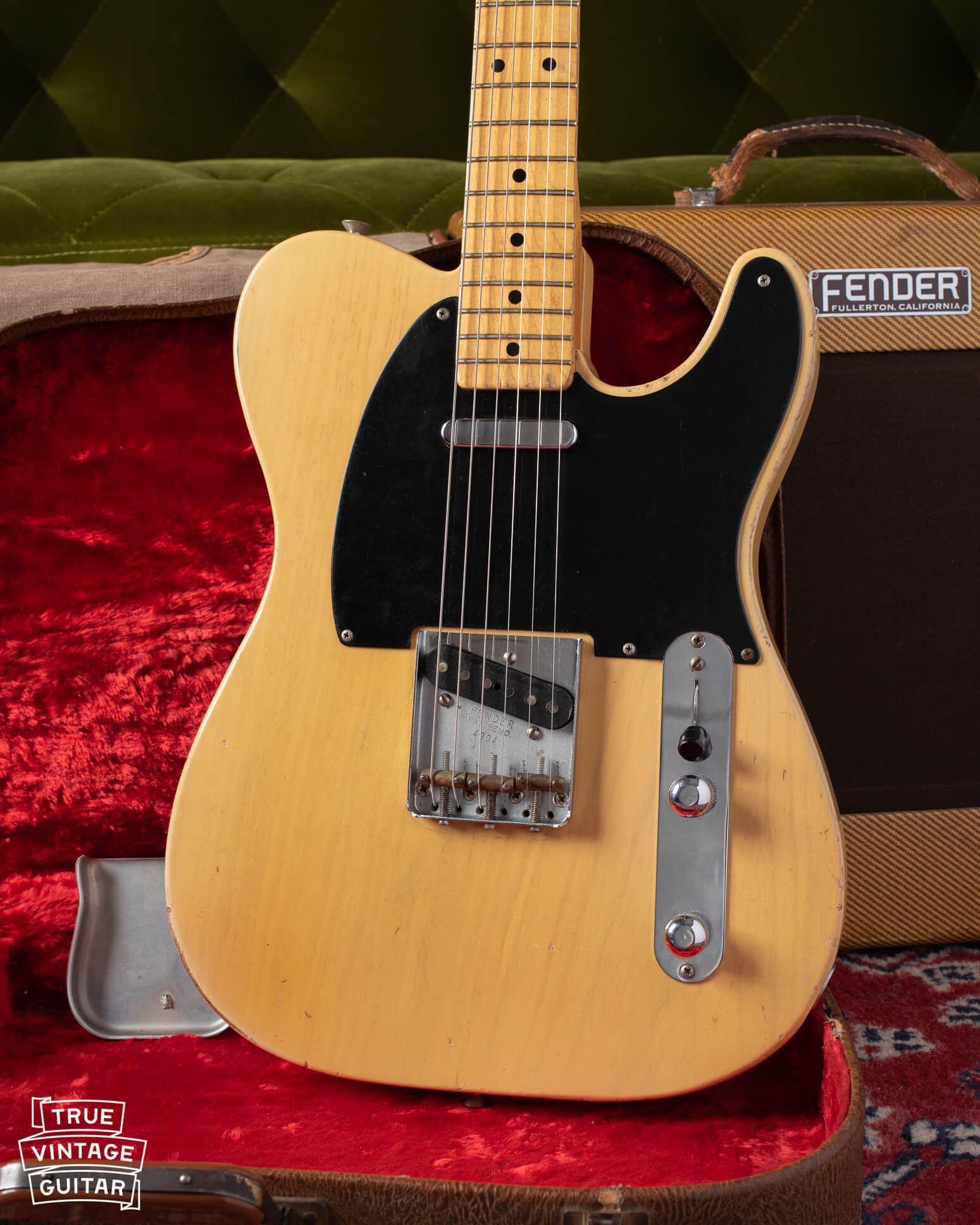1964 was a transitional year for the entire Fender amplifier line. All amplifiers were now covered in a new black material that was striking in appearance and extremely sturdy: black Tolex! Much of the line was already utilizing brown or white Tolex material but the Champ was still dressed in the cool looking but very fragile tweed covering. Not only that, but effects were starting to become standards in guitar tone. Fender's Reverb unit was a hot seller but required hauling around and servicing an additional piece of gear. Fender's research and development team had a fix for that: an entire line of new amps that featured its reverb unit built in to the circuit. The most portable of the line (and in my opinion the best!) was the brand new Princeton Reverb-Amp! Leo Fender and his R&D team were continually tweaking and updating the amp line but the addition of the Reverb circuit was a major milestone.
 The Princeton Reverb-Amp featured a matched pair of 6v6 power tubes, two 12ax7 preamp tubes, a 12at7 and 12ay7 for the reverb send and return. The circuit made about 12 watts through a 10" Jensen or Oxford speaker. The amp remained largely unchanged until late 1967 when Fender introduced the drip edge/silver faceplate cosmetics. The 1964-1967 version with black face plate (often referred to as "blackface") has remained the most collectible version since it's introduction although black line/drip edge edition ('67-'68) is a close second.
The Princeton Reverb-Amp featured a matched pair of 6v6 power tubes, two 12ax7 preamp tubes, a 12at7 and 12ay7 for the reverb send and return. The circuit made about 12 watts through a 10" Jensen or Oxford speaker. The amp remained largely unchanged until late 1967 when Fender introduced the drip edge/silver faceplate cosmetics. The 1964-1967 version with black face plate (often referred to as "blackface") has remained the most collectible version since it's introduction although black line/drip edge edition ('67-'68) is a close second.

 ^^^ This is what is meant by "drip edge/black line. Drip edge refers to the aluminum trim around the grill cloth. The drip edge frame was used from late 1967 until mid 1969. The black line is on either side of the words "PRINCETON REVERB-AMP" on the face plate. The black lines disappear sometime in 1968 so the true drip edge/black line amps were only made for a little less than a year. While the drip edge / black line cosmetic is very cool, the main reason they are desirable is that the interior components were unchanged from the late black face era Princeton Reverb. They still utilized cloth wiring and the same brand of capacitors, resistors, etc. We also usually see large magnet Oxford and sometimes Jensen speakers in the black line amps. I find that these speakers do a significantly better job handling the higher gain and power of a cranked amp. Translation: they sound killer!
^^^ This is what is meant by "drip edge/black line. Drip edge refers to the aluminum trim around the grill cloth. The drip edge frame was used from late 1967 until mid 1969. The black line is on either side of the words "PRINCETON REVERB-AMP" on the face plate. The black lines disappear sometime in 1968 so the true drip edge/black line amps were only made for a little less than a year. While the drip edge / black line cosmetic is very cool, the main reason they are desirable is that the interior components were unchanged from the late black face era Princeton Reverb. They still utilized cloth wiring and the same brand of capacitors, resistors, etc. We also usually see large magnet Oxford and sometimes Jensen speakers in the black line amps. I find that these speakers do a significantly better job handling the higher gain and power of a cranked amp. Translation: they sound killer!
 ^^^ This nice example of a Princeton Reverb-Amp was made in 1971. It was made after the discontinuation of the drip edge trim (1970) but still retains the raised metal tail Fender logo (no tail by 1973) as well as the "-AMP" model name on the face plate (gone by about 1972). The circuit is still unchanged during this time period but it now uses plastic coated wiring and different branded components on the circuit board. The cabinet is still solid Pine finger jointed together on the corners. We like the Pine cabinets much better than the later high pressure laminate cabinets because of their light weight and sturdy build.
Do you have a vintage Fender Princeton Reverb-Amp? I'm always on the hunt for vintage amplifiers in good condition. Contact me here and send some pictures and information about your amp. I'd love to check it out.
^^^ This nice example of a Princeton Reverb-Amp was made in 1971. It was made after the discontinuation of the drip edge trim (1970) but still retains the raised metal tail Fender logo (no tail by 1973) as well as the "-AMP" model name on the face plate (gone by about 1972). The circuit is still unchanged during this time period but it now uses plastic coated wiring and different branded components on the circuit board. The cabinet is still solid Pine finger jointed together on the corners. We like the Pine cabinets much better than the later high pressure laminate cabinets because of their light weight and sturdy build.
Do you have a vintage Fender Princeton Reverb-Amp? I'm always on the hunt for vintage amplifiers in good condition. Contact me here and send some pictures and information about your amp. I'd love to check it out.
 The Princeton Reverb-Amp featured a matched pair of 6v6 power tubes, two 12ax7 preamp tubes, a 12at7 and 12ay7 for the reverb send and return. The circuit made about 12 watts through a 10" Jensen or Oxford speaker. The amp remained largely unchanged until late 1967 when Fender introduced the drip edge/silver faceplate cosmetics. The 1964-1967 version with black face plate (often referred to as "blackface") has remained the most collectible version since it's introduction although black line/drip edge edition ('67-'68) is a close second.
The Princeton Reverb-Amp featured a matched pair of 6v6 power tubes, two 12ax7 preamp tubes, a 12at7 and 12ay7 for the reverb send and return. The circuit made about 12 watts through a 10" Jensen or Oxford speaker. The amp remained largely unchanged until late 1967 when Fender introduced the drip edge/silver faceplate cosmetics. The 1964-1967 version with black face plate (often referred to as "blackface") has remained the most collectible version since it's introduction although black line/drip edge edition ('67-'68) is a close second.

 ^^^ This is what is meant by "drip edge/black line. Drip edge refers to the aluminum trim around the grill cloth. The drip edge frame was used from late 1967 until mid 1969. The black line is on either side of the words "PRINCETON REVERB-AMP" on the face plate. The black lines disappear sometime in 1968 so the true drip edge/black line amps were only made for a little less than a year. While the drip edge / black line cosmetic is very cool, the main reason they are desirable is that the interior components were unchanged from the late black face era Princeton Reverb. They still utilized cloth wiring and the same brand of capacitors, resistors, etc. We also usually see large magnet Oxford and sometimes Jensen speakers in the black line amps. I find that these speakers do a significantly better job handling the higher gain and power of a cranked amp. Translation: they sound killer!
^^^ This is what is meant by "drip edge/black line. Drip edge refers to the aluminum trim around the grill cloth. The drip edge frame was used from late 1967 until mid 1969. The black line is on either side of the words "PRINCETON REVERB-AMP" on the face plate. The black lines disappear sometime in 1968 so the true drip edge/black line amps were only made for a little less than a year. While the drip edge / black line cosmetic is very cool, the main reason they are desirable is that the interior components were unchanged from the late black face era Princeton Reverb. They still utilized cloth wiring and the same brand of capacitors, resistors, etc. We also usually see large magnet Oxford and sometimes Jensen speakers in the black line amps. I find that these speakers do a significantly better job handling the higher gain and power of a cranked amp. Translation: they sound killer!
 ^^^ This nice example of a Princeton Reverb-Amp was made in 1971. It was made after the discontinuation of the drip edge trim (1970) but still retains the raised metal tail Fender logo (no tail by 1973) as well as the "-AMP" model name on the face plate (gone by about 1972). The circuit is still unchanged during this time period but it now uses plastic coated wiring and different branded components on the circuit board. The cabinet is still solid Pine finger jointed together on the corners. We like the Pine cabinets much better than the later high pressure laminate cabinets because of their light weight and sturdy build.
Do you have a vintage Fender Princeton Reverb-Amp? I'm always on the hunt for vintage amplifiers in good condition. Contact me here and send some pictures and information about your amp. I'd love to check it out.
^^^ This nice example of a Princeton Reverb-Amp was made in 1971. It was made after the discontinuation of the drip edge trim (1970) but still retains the raised metal tail Fender logo (no tail by 1973) as well as the "-AMP" model name on the face plate (gone by about 1972). The circuit is still unchanged during this time period but it now uses plastic coated wiring and different branded components on the circuit board. The cabinet is still solid Pine finger jointed together on the corners. We like the Pine cabinets much better than the later high pressure laminate cabinets because of their light weight and sturdy build.
Do you have a vintage Fender Princeton Reverb-Amp? I'm always on the hunt for vintage amplifiers in good condition. Contact me here and send some pictures and information about your amp. I'd love to check it out.



